Day 1 of a 3 day Late Winter/Early Spring tour. It was a very windy day, with sustained winds around 30-40mph and gusts up to 62mph, which always makes life more difficult. Thankfully, after a brief drizzle shower early morning it remained dry, the clouds cleared and the sun came out at times. We persevered and had a very productive day’s birding, despite the wind.
Given the forecast, we headed first to Titchwell, where we could at least get out of the weather in the hides. We had a quick look in the overflow car park, but it was very windy here. A pair of Goldfinches were getting in to the spring spirit, the male displaying in the bushes. As we walked towards the Visitor Centre, we stopped briefly to look at the Scarlet Elf Cup fungus beside the path. There were a few birds coming and going from the feeders, mainly Blue Tits, Great Tits and Chaffinches, and lots of Goldfinches in the alders.
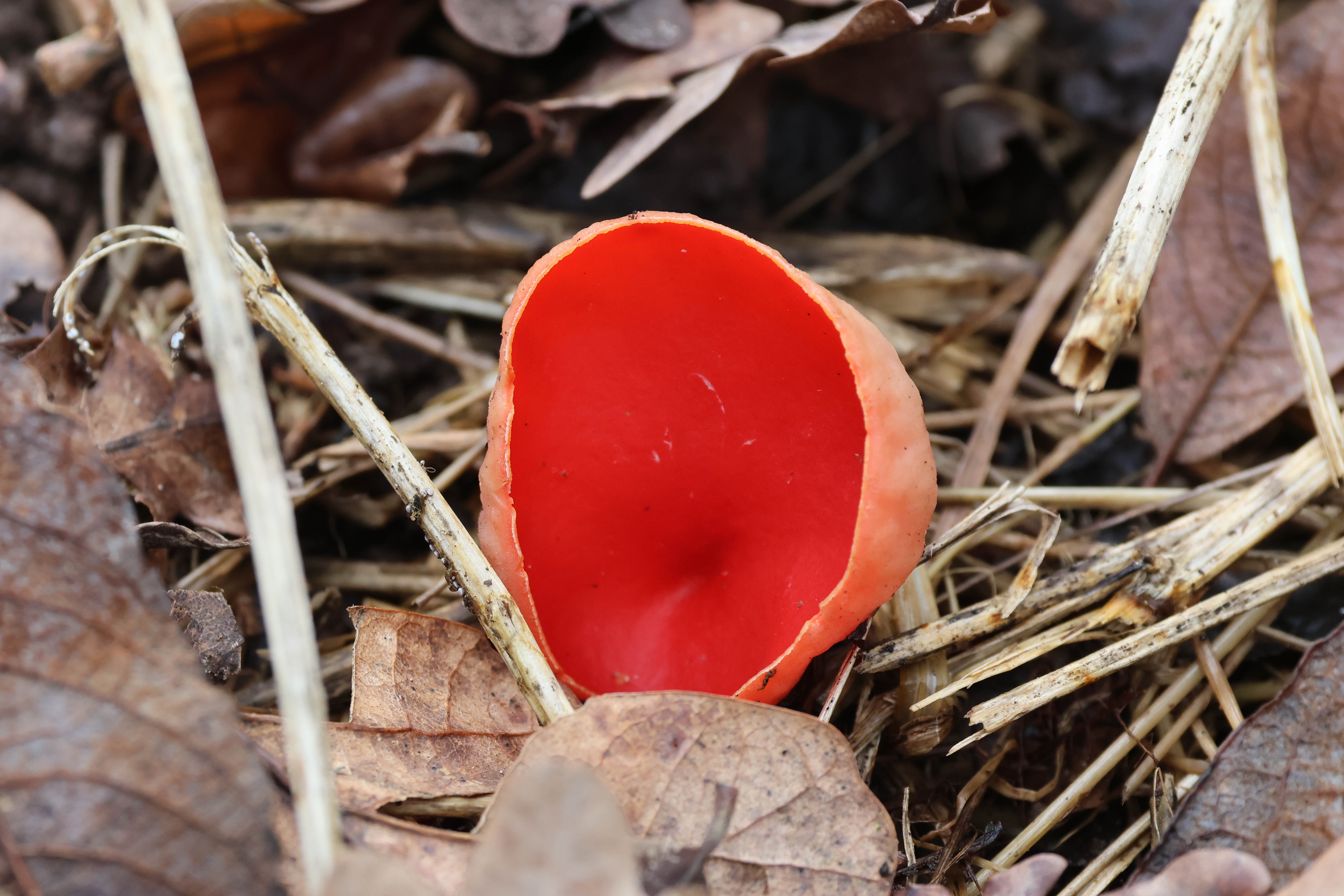
Out on the main path, we stopped in the lee of the last of the trees to scan the marshes. A Marsh Harrier was out over the reeds towards Thornham and as a gaggle of Greylags flew in to the grazing marsh, we noticed six Pink-footed Geese in with them. They landed but promptly tucked their heads down in the grass. Most of the Pink-footed Geese which spent the winter here have already left, so it was good to see a few still here. Two Mediterranean Gulls flew inland, showing off their translucent white wingtips. It started to spit with rain, so we hurried along to Island Hide.
A single bright pink Black-headed Gull was in with the whiter ones on the island nearest the hide – presumably something it had been eating – and there were six Mediterranean Gulls on the next island over. We got the scope on them and admired their jet black heads and excess of white eye liner. A young Spoonbill flew in across the back of the Freshmarsh and dropped down out of view in the far corner.
A pair of Pintail were on the islands too, trying to sleep but splashed with spray, and a few Shoveler and Teal were scattered around out on the water. Several Common Pochard were diving continually out in the choppy water in the middle. A large group of Brent Geese flew in and landed on the water briefly, chattering.
There were a few waders on here too. A couple of Turnstone and a single Ruff were on the islands, along with a few Lapwings. Several Golden Plovers were hunkered down on the bund in front of Parrinder Hide, some starting to get their black summer bellies already, and a small group of Dunlin were running round on the islands beyond. There were lots of Avocets further back.
The rain had eased and the sky had brightened, so we braved the wind and headed round to Parrinder hide. As we got back up onto the bank, three Spoonbills flew past, adults this time, and landed out on the saltmarsh ahead of us. A rather smart Black-tailed Godwit, already well advanced in moult to its rusty breeding plumage, was feeding in the water on the further compartment of the Freshmarsh just below the bank.
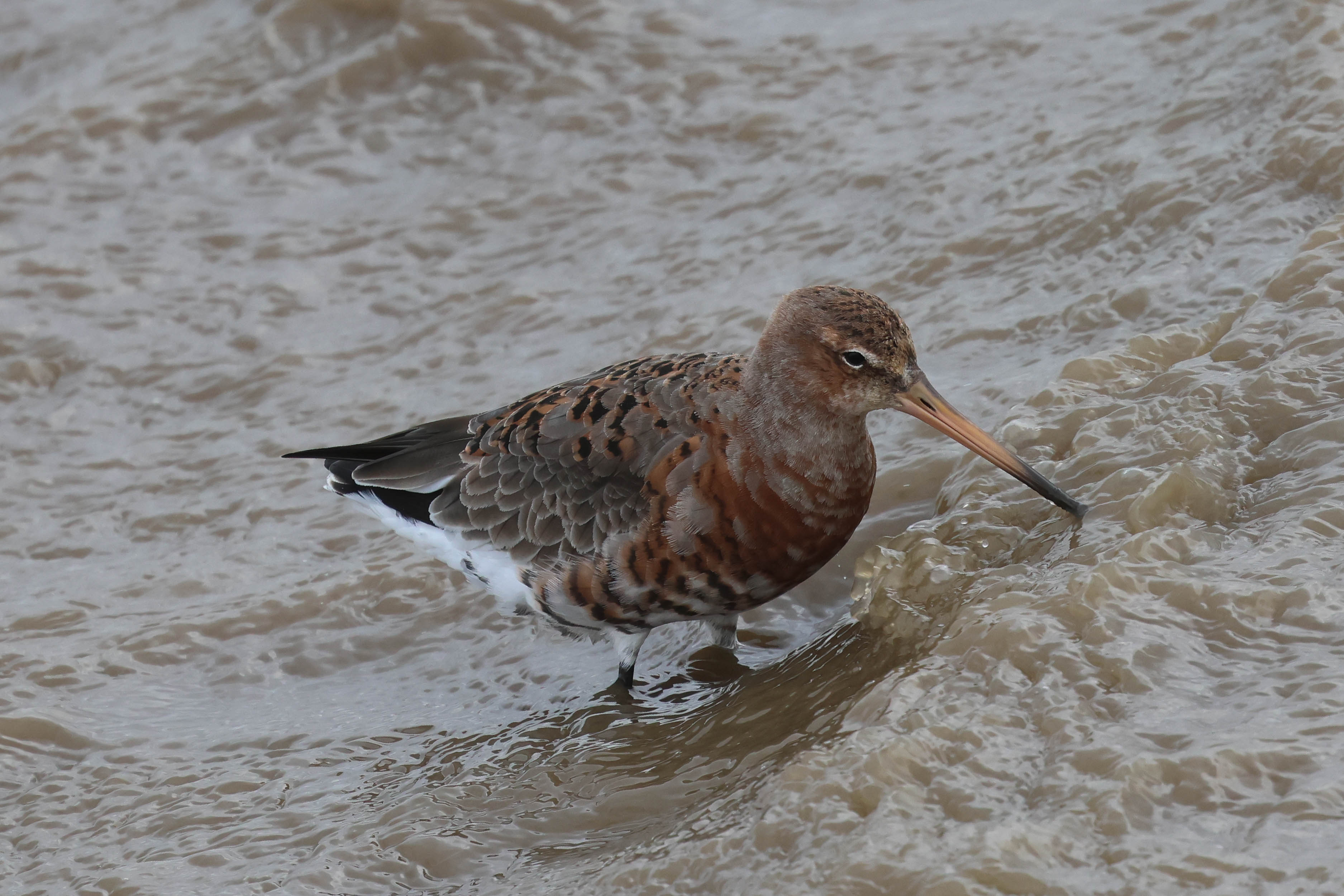
From the shelter of Parrinder Hide, we had a view of the Mediterranean Gulls from behind now, and could see the way the black hood extended further down the neck compared to the Black-headed Gulls. Four Ringed Plovers were on the island in front of the hide, sheltering behind some rocks and even displaying briefly, before running off over the mud.
We could see the juvenile Spoonbill over in the far corner of the Freshmarsh now. Three swans flew over the bank at the back – two Mute Swans followed by the single Whooper Swan which has been lingering here for most of the winter. They swam across in front of the Spoonbill – an odd combination to see with a Whooper Swan here – then stopped to preen below the bund before crossing to the other side and flying off again.
The group of three adult Spoonbills flew in now and landed in front of the hide, hurrying over to preen and feed briefly in the lee of the bund. We had a great view of their shaggy nuchal crests blowing around in the wind, before they flew off again, just as the juvenile Spoonbill worked its way along the edge towards them.
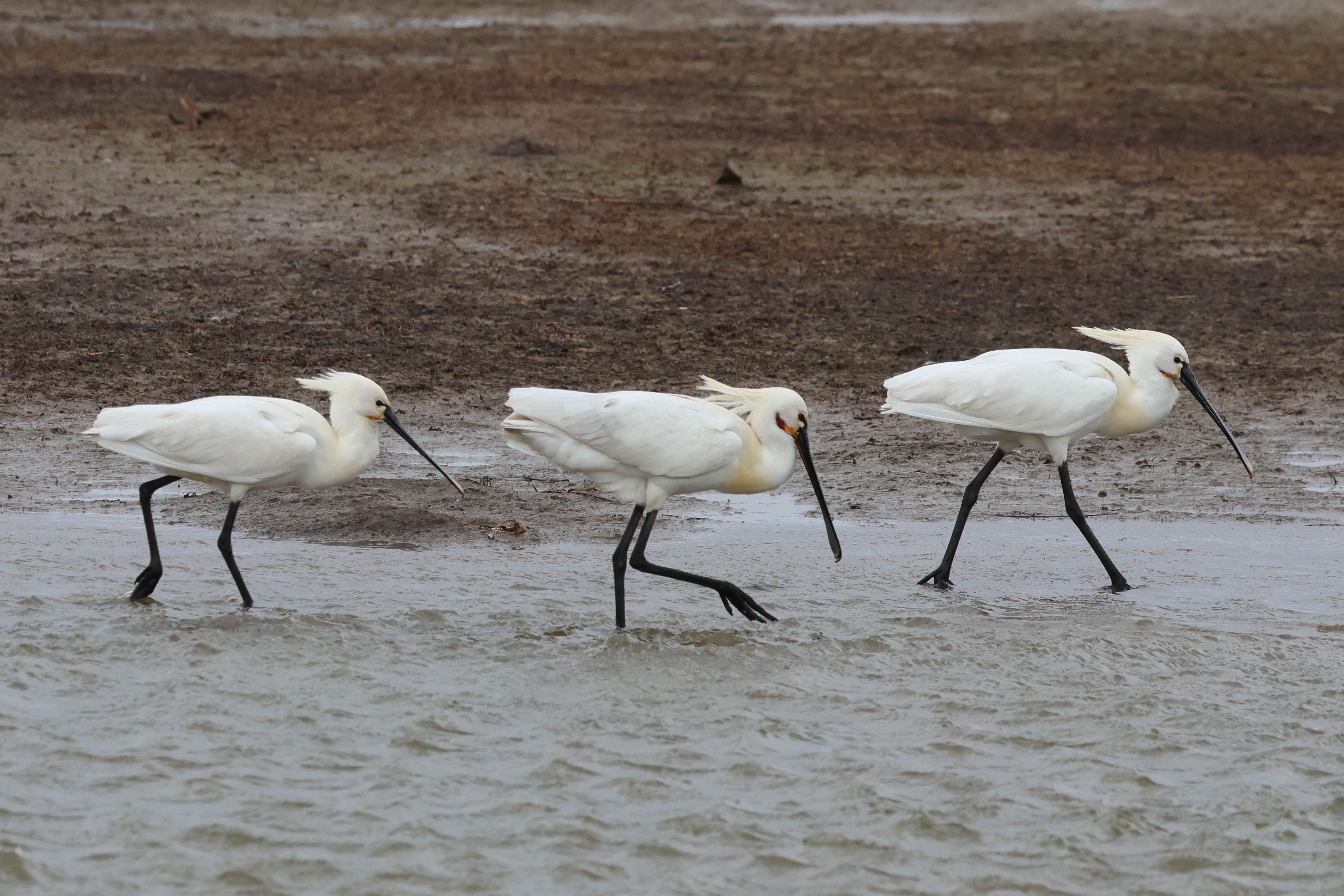
We had nice views of a small group of Dunlin feeding on the mud right in front of the hide here and a Common Snipe feeding in the grass right below the window. A Ruff dropped in at one point, a Grey Plover was sheltering from the wind on the bund and a Curlew was feeding in the vegetation on the bank.
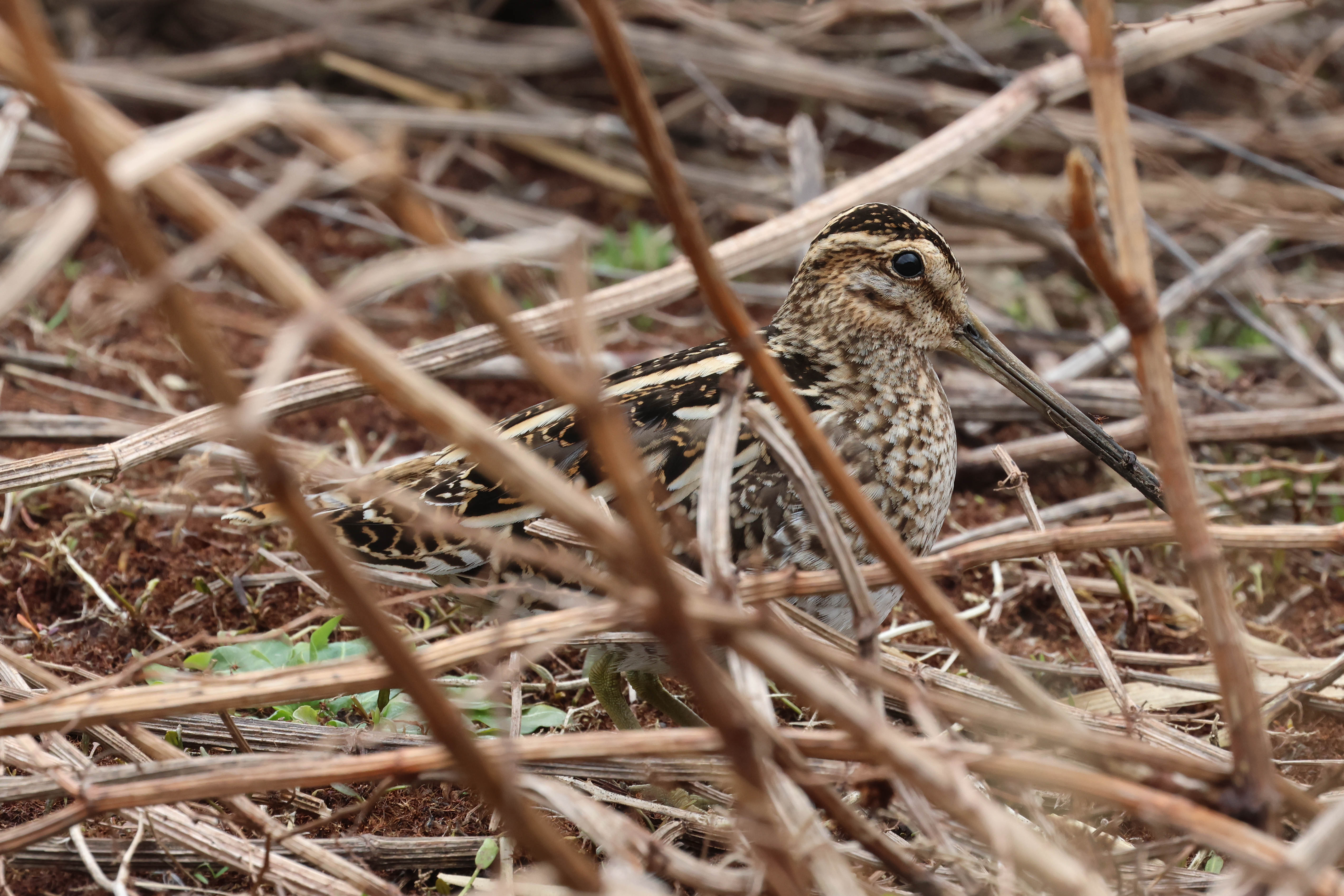
A little group of Teal were chasing round on the water close to the hide, the males occasionally displaying, throwing their heads back and flicking their tails up. A pair of Gadwall were on the bank too and several Wigeon out on the islands.
We had a quick look in the other side of Parrinder Hide, out at the Volunteer Marsh, but it was mostly devoid of birds – a small group of Brent Geese feeding right over by the far bank and singles of Grey Plover and Redshank. With the tide just going out, we thought it might be worth a quick look in the channel at the far end of Volunteer Marsh, so we went back out into the wind and walked a short way up the main path. There were a few Black-tailed Godwits and Redhanks on the mud, but nothing different.
The Spoonbills had now flown out onto the saltmarsh opposite and gone to sleep, the three adults now joined by the juvenile. The nuchal heads of the adults were getting blown back over their heads – a bad hair day! The sea looked quite rough and it was very windy out on the bank so we decided against walking on to the beach and, heads down, hurried back to the shelter of the trees and the Visitor Centre.
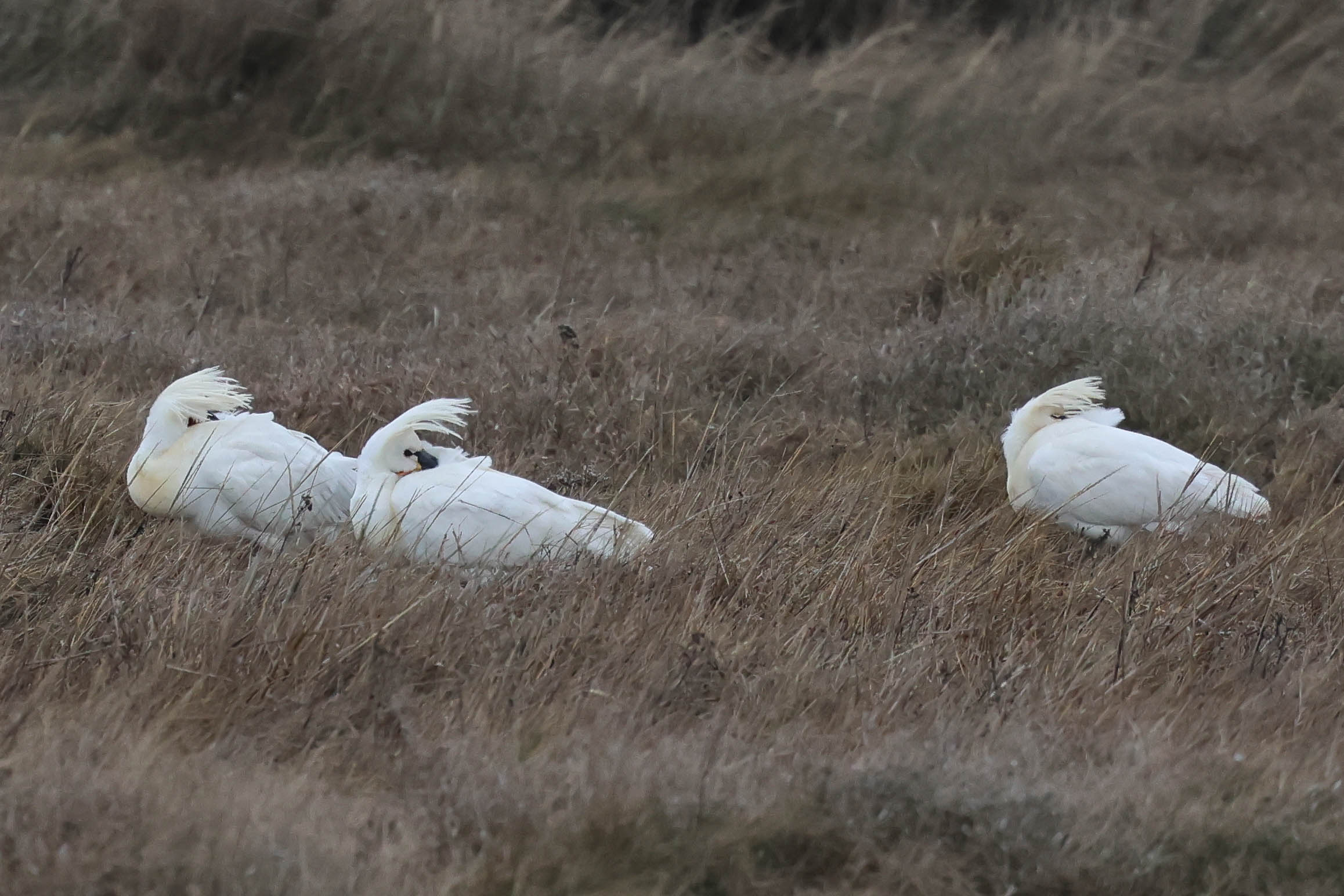
We made our way back east next, stopping first at Brancaster Staithe to scan the harbour from the shelter of the minibus. A Grey Plover, a Turnstone and a Ringed Plover were feeding on the near edge of the water and several Oystercatchers and more Turnstones were picking around the discarded mussels further up. A Bar-tailed Godwit was in the shallow water in the middle and as the tide receded and the sandbar emerged, four Brent Geese battled in against the wind and landed deftly on the wet sand.
Several Black-headed Gulls were roosting in the shelter of the muddy bank to one side and a single adult Mediterranean Gull was in with them. The Mediterranean Gull had a white colour-ring on one of its legs, so we took some photos and looked up the ringing scheme when we got back later. Thankfully we got a very quick reply to our email from the ringers in Belgium: it was ringed as a nestling in June 2018 near Antwerp, and has been seen subsequently in various parts of UK, in Spain and back in Belgium. It will be interesting to see if it joins the colony on nearby Scolt Head.

Our next stop was at Holkham. Lady Anne’s Drive was closed today, due to the wind, so we stopped to scan the grazing marshes in the lee of the Park. There were not so many geese out on the marshes today, and mainly Greylags, but we did eventually find a few White-fronted Geese, several were hiding in the lee of the old fort but four were out in the middle with a couple of Greylags. Another group was behind the reeds right over the back, in front of the pines. A Great White Egret was over to the left, in front of the small wood and several Grey Herons were hiding in the rushes. A green tagged Marsh Harrier was hunting over the marshes but too far away to read the tag.
Scanning with the scope, we picked up a Sand Martin battling its way west. Unfortunately it was distant and impossible for anyone else to get onto. We had just been talking earlier about when the first spring migrants with start to come through, but this was the first one we had seen, and one of the earliest Sand Martins we have seen here. Not what we were expecting given the conditions, although the wind was a warm one from the SW. A Goldcrest shot across past us and disappeared into the hedge the other side.
We made our way round to Wells beach car park next and stopped for lunch in the warmth of the minibus today. Afterwards, we went out to take a look at the harbour. It was sheltered on the beach side of the lifeboat station and warmer in the sunshine now. There were four Red-breasted Mergansers distantly in the outer channel and a single Common Seal hauled out on the beach.
We scanned through the waders on the sands opposite, lots of Oystercatchers scattered liberally and small roosting groups of Sanderlings and Bar-tailed Godwits hiding in between the sand ridges. More Sanderling were running around on the sand and more godwits feeding in the shallow water. There were a few Dunlin here too.
From further down, towards the site of the old lifeboat station, we could see a few Knot higher up the beach, several Grey Plover and Ringed Plover, and a larger group of roosting Dunlin. There were more Red-breasted Mergansers, six of them, three drakes and three redhead females. They were much closer here and we had a great view of their punk haircuts in the scope. One of the males even started to display, throwing its head forward and up and then flicking its rear end up. It was too windy to walk on round further here, without getting sand blasted, so we turned and made our way back the way we had just come.

There seemed to be lots of Black-tailed Godwits on the flood at Stiffkey today, as we passed. We stopped on the road briefly to have a quick scan, but couldn’t see anything with them. There is too much traffic to linger here, so we parked a bit further on and walked back down along the footpath. The Long-billed Dowitcher has been seen here with the godwits at times, but despite scanning the flood with the scope we couldn’t see it with them today. It was hard viewing from here though, looking into the wind and the sun. There was a tree down across the footpath so we couldn’t go further, so we turned round and headed back.
We carried on east to Cley and got out of the wind in Bishop Hide. We were hoping for a Water Pipit, but there was a Pied Wagtail along the front edge of the scrape again which has been chasing everything off. A Grey Wagtail did drop in several times and fed on the bank right in front of the hide. Scanning further round, we eventually found a couple of Water Pipits in among the lumps of mud on the bank right at the back, along with a Meadow Pipit for comparison.

There were three drake Pintail in the far corner when we arrived and they gradually worked their way over towards us, upending continually and showing off their long pin-shaped central tail feathers. When they arrived in the corner in front of the hide, they were repeatedly chased by a rather aggressive drake Shelduck.
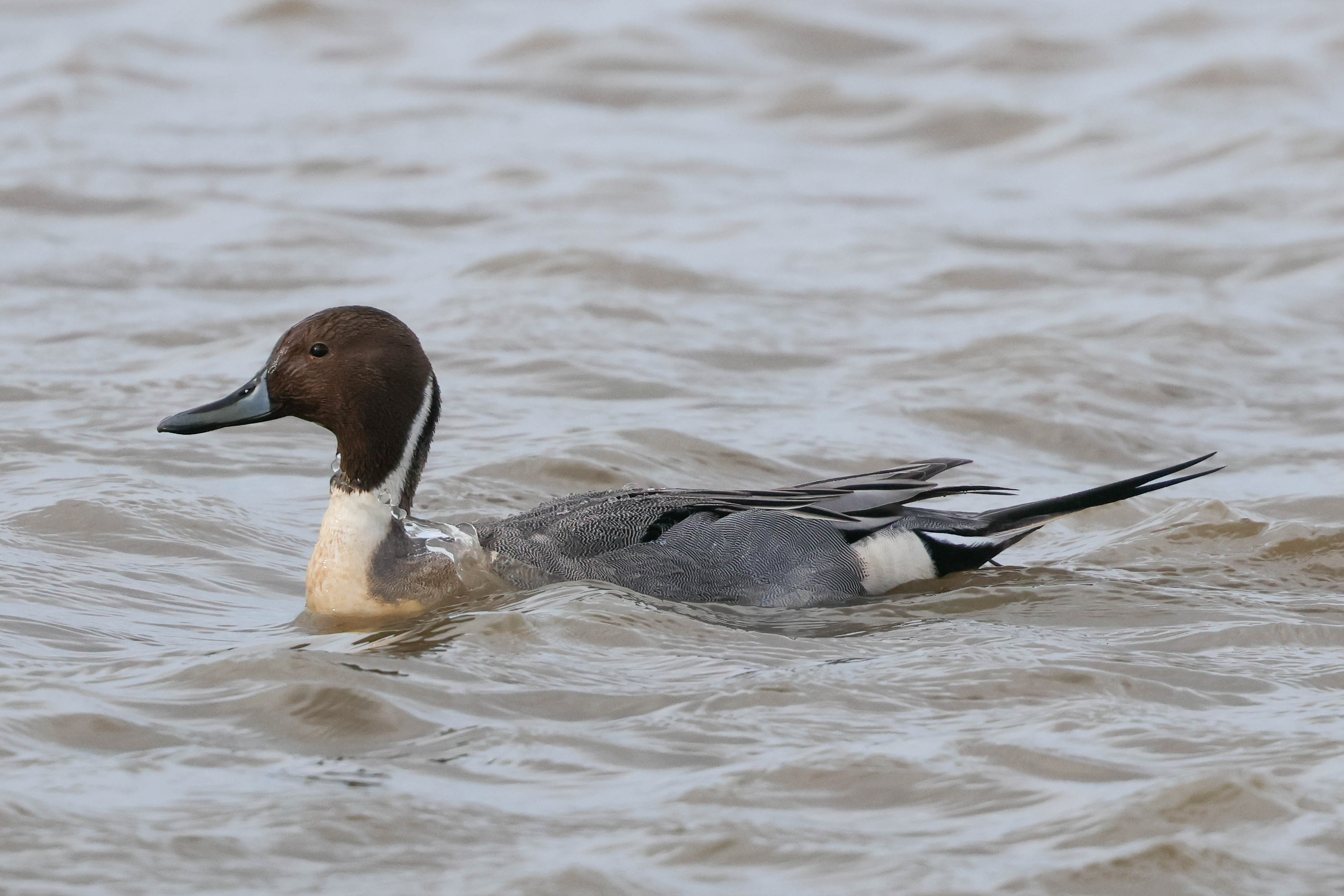
There had been another Sand Martin reported flying west through Cley earlier, after ours at Holkham, so when we picked one up flying low over the tops of the reeds at the back, we presumed it was most likely the same one lingering. Now everyone got a chance to see this one. It mostly went round and round over the same line of reeds but once or twice made forays out over the scrape and at one point came round behind the hide and then flew back out in front. Do two Sand Martins make a summer? It certainly didn’t feel like it today!

There was a nice selection of waders on the scrape, several Ruff, Lapwings and Avocets, and some small groups of Dunlin. A Marsh Harrier kept coming in over the reeds to the edge of the scrape. It was nice sitting here in the hide out of the wind, but it was now time to head back. We had a remarkably good day today, considering the wind. More (though hopefully less wind) tomorrow.
















